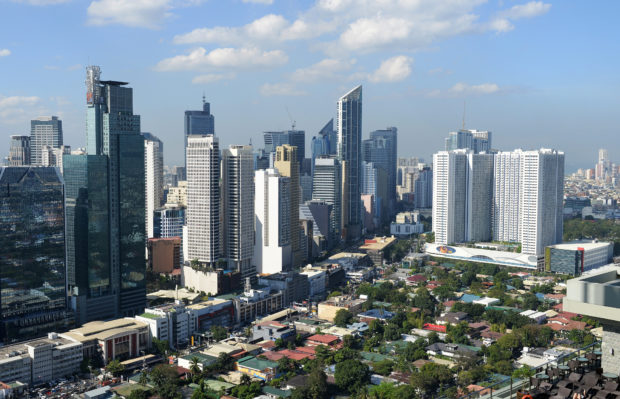
This photo taken on Jan 29, 2019 shows a general view of the skyline of the financial district of Makati in Manila. (Photo by Ted ALJIBE / AFP)
The benchmark interest rates of the Bangko Sentral ng Pilipinas (BSP) could rise by as much as 50 basis points (bp) or 0.5 percentage point (ppt) next week as the unexpected acceleration in inflation last month suggests that the rate of increase in prices of goods and services has not yet peaked.
In a commentary, the New York-based think tank GlobalSource Partners noted that a particularly strong 1.7 -percent month-on-month jump in consumer prices sent the headline inflation rate to a 14-year high 8.7 percent in January.
“Perhaps most concerning for monetary authorities is the relatively sharp 7.4 percent year-on—year rise in core inflation, revealing rising demand side price pressures,” said Romeo Bernardo, GlobalSources’ analyst for the Philippines.
Bernardo said that despite the extension of reduced tariff rates for key commodities—including pork, corn, rice and coal—through Executive Order 10, the latest inflation print points to the need for other urgent measures to plug supply shortfalls and bring down prices of food items.
“As it is, the current momentum will likely see the headline inflation rate continue to trek up and bring the average inflation rate for the year to around 7 percent, much higher than our previous 4.8 percent forecast,” he said.
To tamp down inflation, there is consensus that the BSP will continue to raise its policy rate that currently stands at 5.5 percent. The only question is by how much the Monetary Board will increase it when it meets on Feb. 16.
“With January inflation surprising on the upside and expected to raise inflation expectations, a minimum 25 bp [0.25 ppt] increase in domestic policy rates looks guaranteed at the moment,” Bernardo said.
For The Netherlands-based ING Bank, next week’s meeting could see policymakers doubling down on tightening with a 0.5-ppt hike.
ING Bank senior economist Nichola Mapa said that following the January results, the BSP will need to front load its rate hikes to rein in inflation expectations which are now in danger of deviating from the BSP’s own forecast as well as target range of 2 percent to 4 percent.
“BSP will also need to move up its rate increases to February to display its commitment to price stability and convince market participants and the public alike that it is willing to do all it can to bring back inflation within target at the soonest,” he said.
Previously, the ING Bank economist said the BSP would raise rates by 0.25 ppt each in February and in March. He is keeping this expectation, except that it would be a 0.5-ppt hike in February and possibly none in March.
For the United Kingdom-based Pantheon Macroeconomics, which had been expecting no more hikes—or a pause—by the BSP before January inflation data came out, a 0.25-ppt increase next week “is now set in stone.”
“At the same time, though, we maintain that disinflation will be the main theme this year, with 50bp-worth of interest rate cuts still likely, in the fourth quarter,” said Miguel Chanco, Pantheon Macroeconomics’ chief economist on emerging markets in Asia.